
Sports Injuries, Synapse Physiotherapy
Introduction
Massage therapy uses touch and manipulation of soft tissues to treat pain, relax the body, and prevent injury. There are various types of massage therapy, each offering unique benefits. Two of the most common types are deep tissue massage therapy and sports massage therapy. While these techniques are similar, the best choice depends on your lifestyle, goals, and needs. You can receive a sports massage or deep tissue massage from a certified physiotherapist at a nearby physiotherapy center.
What is Sports Massage?
Sports massage is a deep form of soft tissue mobilization that can be beneficial in both sporting and non-sporting contexts. It employs various techniques, including effleurage, kneading, wringing, hacking, and trigger pointing. Sports massage aims to relax the musculoskeletal system and address specific problem areas. This type of massage helps relieve muscular tension, break down adhesions, mobilize soft tissues, and reduce pain.
Benefits of sports massage.
Reducing Delayed Onset Muscle Soreness (DOMS)
Sports massage is effective in reducing delayed onset muscle soreness (DOMS), which can arise from minor muscle or connective tissue damage, local muscle spasms that limit blood flow, or a buildup of waste products from energy production. By reducing muscle spasms, flushing out waste products, and increasing blood flow, sports massage helps alleviate DOMS. Increased blood flow delivers oxygen and nutrients to aid in the repair of damaged tissues.
Integrating into a Training Program
Incorporating sports massage into a training program helps the body recover from the stresses of exercise and facilitates the rebuilding phase of conditioning. It improves blood and lymph circulation, promotes muscle relaxation, and provides general relaxation. Additionally, sports massage helps flush out waste products and enhances cell nutrition, leading to relief from soreness and stiffness, increased flexibility, and a reduced risk of future injury.
Post-Event Recovery
Sports massage is beneficial after sporting events such as a 10k run, football match, or cycle race, as well as after workouts or gym classes. It aids muscle recovery, prevents injuries, and prepares the body for future exercise. By reducing muscle spasms and the metabolic buildup of waste products that occur during exercise, sports massage enhances post-event recovery.
Pre-Event Preparation
Pre-event massage can be administered directly before exercise or in the weeks leading up to an event. It helps improve performance and decreases the chance of injury by enhancing circulation, increasing tissue elasticity, and reducing muscle tension. As part of a warm-up routine, sports massage prepares the muscles for exercise.
Relieving Tight Muscles
Muscle tightness can limit flexibility, increase pain, and lead to future injuries. Sports massage helps release muscle tightness by increasing blood flow through tight muscles, breaking down inflexible tissues, and stretching out muscle fibers. Regular use of sports massage to relieve tight muscles can reduce the risk of injury and maximize performance.
What is a deep tissue massage?
Deep tissue massage targets chronic tension in muscles located deep beneath the body’s surface. This technique involves slow strokes, direct pressure, or friction movements that go across the muscle grain. Chronic muscle tension or injury often leads to adhesions (bands of painful, rigid tissue) in muscles, tendons, and ligaments, which can block circulation and cause pain, limited movement, and inflammation. Deep tissue massage works by physically breaking down these adhesions to relieve pain and restore normal movement.
Physiotherapists use their fingers, thumbs, or occasionally elbows to apply the necessary pressure. This technique is particularly helpful for chronically tense and contracted areas such as stiff necks, low back tightness, and sore shoulders. While some of the same strokes used in classic massage are employed, the movements in deep tissue massage are slower, and the pressure is deeper and concentrated on areas of tension and pain.
Unlike classic massage therapy, which is primarily for relaxation, deep tissue massage usually focuses on specific problems, such as chronic pain, limited mobility, recovery from injuries (e.g., whiplash, falls, sports injuries), osteoarthritis pain, fibromyalgia, and muscle spasms.
Benefits of Deep Tissue Massage
Pain Relief
Research shows that deep tissue massage can effectively alleviate chronic neck and lower back pain, as well as pain following a C-section. People with myofascial pain syndrome, which causes pain in the muscles and fascia, may also benefit from deep tissue massage.
Joint pain often results from an imbalance in the muscles’ length-tension relationship—the correlation between the length of muscle fibers and the force they generate. By releasing tension in one area, deep tissue massage can reduce discomfort in another, providing relief for conditions like arthritis.
Improved Range of Motion
Deep tissue massage can enhance the range of motion for many individuals. A 2023 study with 41 participants aged 20 to 34 showed that a single session of deep tissue massage significantly improved the cervical spine’s range of motion for up to two weeks after the treatment.
Relief for Symptoms of Anxiety and Depression
Certain types of touch and massage can help relax the body’s stress response. A review on the role of massage therapy in treating various psychiatric disorders found that massage might be beneficial for individuals with depression, anxiety, and insomnia, particularly as a complementary therapy to other treatments.
Improved Body Awareness
Deep tissue massage can increase awareness of previously unnoticed or ignored tightness or discomfort in the body. This heightened awareness helps patients understand where they hold tension, which is crucial for taking steps toward healing and improving mind-body communication regarding the body’s well-being.
Differences between sports massage and deep tissue massage
While both deep tissue and sports massage involve manual therapy to alleviate muscle tension, they differ significantly in their techniques and objectives.
Deep tissue massage is primarily used to address chronic pain and muscle tension by focusing on the deeper layers of muscle tissue. This type of massage employs slow strokes, direct pressure, and friction movements that work across the muscle grain. The primary objective of deep tissue massage is to break down adhesions, relieve pain, and restore normal movement. It is particularly beneficial for individuals dealing with chronic conditions such as persistent back pain, fibromyalgia, or ongoing muscle tightness and spasms.
In contrast, sports massage is more targeted, addressing specific areas of the body that are strained or injured due to athletic activities. This form of massage is designed to prepare the body for physical exertion, aid in recovery after intense exercise, and prevent injuries. Techniques in sports massage include effleurage, kneading, wringing, hacking, trigger pointing, stretching, and joint mobilization. These methods help reduce delayed onset muscle soreness (DOMS), improve flexibility, and enhance overall athletic performance. Sports massage is beneficial not only post-event but also as part of a pre-event routine to enhance circulation, increase tissue elasticity, and reduce muscle tension.
Overall, while deep tissue massage focuses on alleviating chronic pain and tension in deeper muscle layers, sports massage is tailored to the needs of athletes, emphasizing preparation and recovery related to physical activities.
When do you need it?
When deciding between a deep tissue massage and a sports massage, your specific conditions and needs should guide your choice. If you’re uncertain about which type of massage to choose, you can base your decision on the functions listed above or seek an assessment from a professional physiotherapist. A physiotherapist can evaluate your specific needs and recommend the most appropriate type of massage. Synapse Physiotherapy offers both deep tissue and sports massage, ensuring that you receive the treatment best suited to your condition.
FAQs
1. What is the primary purpose of sports massage?
Sports massage is primarily aimed at enhancing athletic performance, reducing recovery time, and preventing injuries in active individuals.
2. How does deep tissue massage differ from a regular massage?
Deep tissue massage targets deeper muscle layers and connective tissues, addressing chronic pain and stiffness, while regular massages focus on relaxation and surface-level tension relief.
3. Can sports massage help with non-sports-related injuries?
Yes, sports massage can be beneficial for treating various musculoskeletal issues, even in non-athletes, by improving circulation and reducing muscle tension.
4. Is one massage better for chronic pain management?
Deep tissue massage is generally more effective for chronic pain management because it targets the deeper muscle layers and breaks down adhesions that contribute to long-term discomfort.
5. How often should you get a sports massage if you are an athlete?
The frequency depends on your training intensity, but most athletes benefit from a sports massage at least once a week to maintain optimal performance and recovery.
Conclusion
In conclusion, both sports massage and deep tissue massage offer valuable benefits, depending on individual needs. For those experiencing chronic pain or muscle tension, deep tissue massage can provide effective relief by targeting deeper muscle layers. Athletes or individuals engaged in intense physical activities may benefit from sports massage, which aids in recovery and reduces delayed onset muscle soreness (DOMS). Ultimately, a thorough assessment by a qualified therapist will determine the most appropriate treatment. At Synapse Physiotherapy, our skilled physiotherapists offer both services, ensuring personalized care to meet your specific requirements.
Tags :

Back & Neck Pain
Conditions such as stiffness, postural abnormalities and muscle overuse from prolonged desk work at the office or home is more prevalent than most would think. We provide the necessary tools to fix you up and educate you on ergonomics which can unload unnecessary stress.
- Spine & Core Rehabilitation
- Strength & Conditioning Programme
- Pain Management
- Biomechanical Assessment
- Sports Physiotherapy
- Group Class
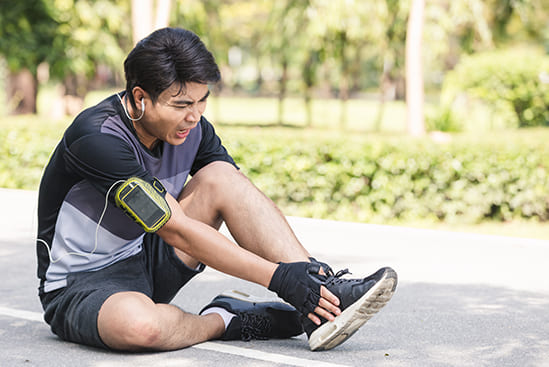
Sports Injuries
Rolled ankles, jarred knees, impinged shoulders are few conditions in the plethora of sports injuries which can hamper performance and limit our enjoyment of sports. Physiotherapy not only treats the symptoms of these conditions but propels your overall fitness to greater heights.
- Strength & Conditioning Programme
- Pain Management
- Biomechanical Assessment
- Sports Physiotherapy
- Shockwave Therapy
- Group Class

Work Desk Injuries
Conditions such as stiffness, postural abnormalities and muscle overuse from prolonged desk work at the office or home is more prevalent than most would think. We provide the necessary tools to fix you up and educate you on ergonomics which can unload unnecessary stress.
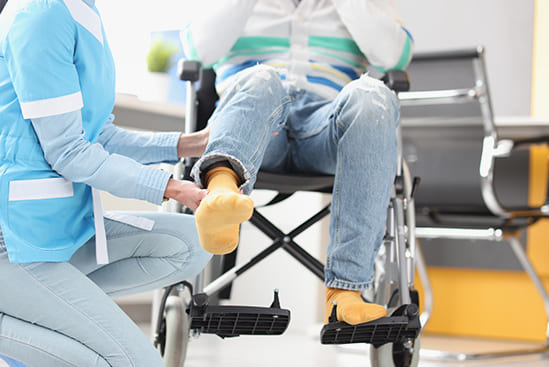
Pre-Post-Surgical Conditions
Surgery involves going through preparation both before and after. Physiotherapists play a vital role in getting your body ready for surgeries with circulatory, breathing and strengthening exercises. After the procedure, let us be there for your recovery and rehabilitation, taking it one step at a time.

Scoliosis & Postural Abnormalities
The way we stand, sit, walk and sleep has influence over our posture and the overall balance of muscles controlling its alignment. A comprehensive screening can be done by our physiotherapists to detect abnormalities, which we will aid in correcting.
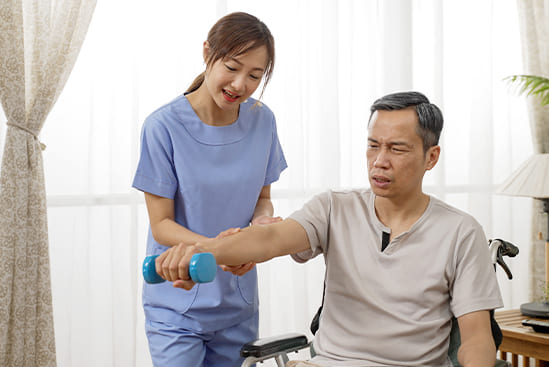
Neurological Conditions
Neurological disabilities such as stroke, nerve compression and neuropathies can be barriers for patients to live life to its fullest. We at Synapse are committed to help you overcome these hurdles by ensuring functional mobility and quality of life is at its optimum by providing the right treatment and exercises.
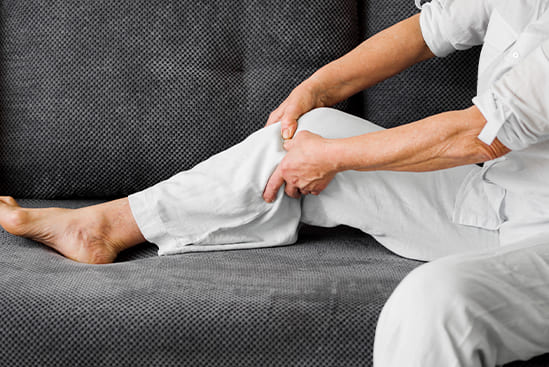
Osteoarthritis & Rheumatism
Joint degeneration and inflammation happens as the human body grows older, but that does not mean our way of life degenerates as well. Relief your joint pains with a joint effort together with your physiotherapist, who will provide pain-relief treatments and prescribe exercises for your wellbeing.
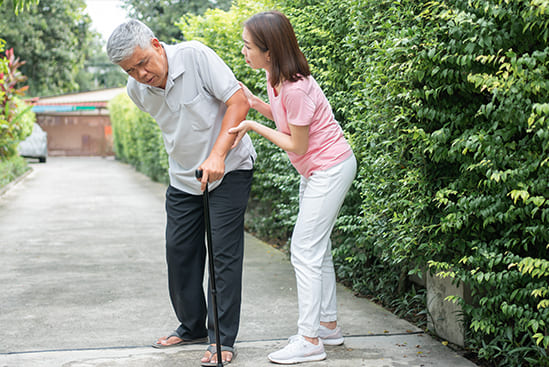
Conditions Relating To Elderly
Common conditions in the older age population include hips & knee pain, back & neck pain, osteoarthritis, rheumatism, fear of falling and many more. Aging and degeneration of bodily function is inevitable, but here at Synapse, we will help you live the best of your life.

Home Physiotherapy
We understand that some conditions or injuries can make it difficult to receive rehabilitation at our clinic be it mobility or transportation issues. Our objective is to provide you with the same high-quality physiotherapy services at home that you would receive in-clinic.
